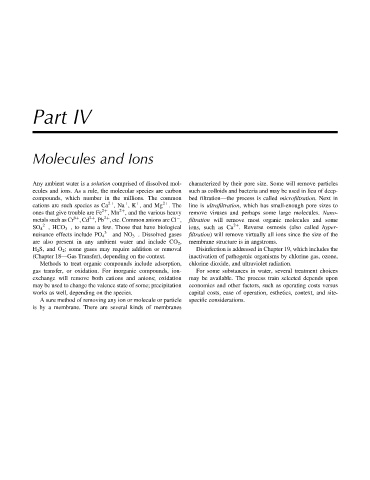Page 500 - Fundamentals of Water Treatment Unit Processes : Physical, Chemical, and Biological
P. 500
Part IV
Molecules and Ions
Any ambient water is a solution comprised of dissolved mol- characterized by their pore size. Some will remove particles
ecules and ions. As a rule, the molecular species are carbon such as colloids and bacteria and may be used in lieu of deep-
compounds, which number in the millions. The common bed filtration—the process is called microfiltration. Next in
cations are such species as Ca ,Na ,K , and Mg . The line is ultrafiltration, which has small-enough pore sizes to
2þ
þ
þ
2þ
ones that give trouble are Fe ,Mn , and the various heavy remove viruses and perhaps some large molecules. Nano-
2þ
2þ
metals such as Cr ,Cd ,Pb , etc. Common anions are Cl , filtration will remove most organic molecules and some
6þ
2þ
2þ
SO 4 , HCO 3 , to name a few. Those that have biological ions, such as Ca . Reverse osmosis (also called hyper-
2
2þ
3 and NO 3 . Dissolved gases filtration) will remove virtually all ions since the size of the
nuisance effects include PO 4
are also present in any ambient water and include CO 2 , membrane structure is in angstroms.
H 2 S, and O 2 ; some gases may require addition or removal Disinfection is addressed in Chapter 19, which includes the
(Chapter 18—Gas Transfer), depending on the context. inactivation of pathogenic organisms by chlorine gas, ozone,
Methods to treat organic compounds include adsorption, chlorine dioxide, and ultraviolet radiation.
gas transfer, or oxidation. For inorganic compounds, ion- For some substances in water, several treatment choices
exchange will remove both cations and anions; oxidation may be available. The process train selected depends upon
may be used to change the valence state of some; precipitation economics and other factors, such as operating costs versus
works as well, depending on the species. capital costs, ease of operation, esthetics, context, and site-
A sure method of removing any ion or molecule or particle specific considerations.
is by a membrane. There are several kinds of membranes

